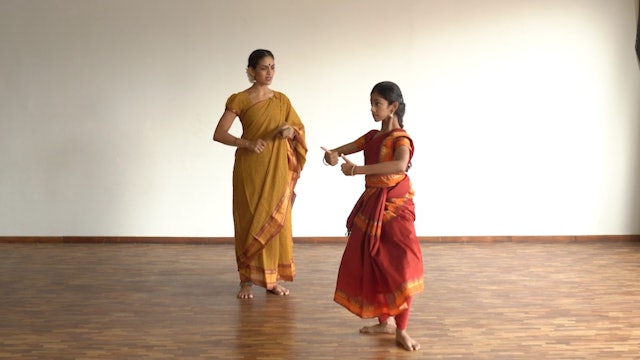-
Adi Tala Korwe 3
Please watch the first three lectures on Talam before beginning the Korwe series. There is an instruction video for each Korwe.
A Korwe is a set of adavus that are formatted to a specific rhythmic structure, ending with a Muktayam/Teermanam adavu and layered on a Swara like in a Jatiswaram or Ta...
-
Tishra Eka Korwe 1
Please watch the first three lectures on Talam before beginning the Korwe series. There is an instruction video for each Korwe.
The Korwe series continues with a variety of Talams. This is the first Korwe you will learn in Tishra Eka Talam.
Try to notice the difference in the rhythmic cycle as...
-
Adi Tala: Pancha Nadai/ Jathi Korwe
Please watch the Talam lectures upto Lecture 5 before beginning this Korwe. There are two parts for the instruction of this Korwe, in Adi Talam.
The Korwe series continues with a variety of Talams. This is the first Korwe in Adi Talam that layers the adavus in all 5 Jathis. (Tishra, Chatushra, K...
-
Pushpanjali
Pushpanjali
Raaga: Aarabhi
Aditala
Composer: Dr Balamuralikrishna
Choreography: Rukmini VijayakumarThe Pushpanjali is choreographed with many rhythmic layers. You will have an appending document that you can download to understand the Rhythm clearly.
There is an added verse from the Ganesha P...
-
Jatiswaram: Raga Rasikapriya
The second piece that is traditionally presented in a Margam is a Jatiswaram. A Jatiswaram is named as such because it is a combination of a Jathis and Swarams. It begins with a Jathi typically followed by the Pallavi, Anupallai and Charanams, to which multiple Korwes are choreographed.
This pa...
-
Jatiswaram: Part 2
Raga : Rasikapriya
Adi Tala
Composer : Lalgudi G JayaramanThe Jatiswaram will be taught in parts with detailing on rhythm and alignment.
A Jatiswaram is traditionally performed after an Alaripu or Pushpanjali in a BHaratanatyam performance, a combination of Jatis and Swaras, it is a piece that...
-
Jatiswaram: Part 3
Raga : Rasikapriya
Adi Tala
Composer : Lalgudi G JayaramanThe Jatiswaram will be taught in parts with detailing on rhythm and alignment.
A Jatiswaram is traditionally performed after an Alaripu or Pushpanjali in a BHaratanatyam performance, a combination of Jatis and Swaras, it is a piece that...
-
Talam: Lecture 9, Gati
Gati's are used to bring rhythmic variation within the structure of a talam, by changing the number of syllables per beat.
Gati variations are used in many compositions and are important to understand before learning choreography.
-
Shiro bheda Shloka
The head is considered one of the Angas, or major limbs according to the Natyashastra.
The movements of the head are used not only for the precise control in the execution of Nritta but also to communicate meaning in the context of gesture.
Please refer to the Shloka below for pronunciation. ...
-
Pārśva Bheda Shloka
The side, Parshva is considered one of the Angas, or major limbs according to the Natyashastra.
The movements of the side are used not only for the precise control in the execution of Nritta but also to communicate meaning in the context of gesture.
Please refer to the Shloka below for pronun...
-
Pādah bheda Shloka
The feet are considered one of the Angas, or major limbs according to the Natyashastra.
The movements of the feet are used not only for the precise control in the execution of Nritta but also to communicate meaning in the context of gesture.
Please refer to the Shloka below for pronunciation. P...
-
Katī bheda Shloka
The hips are considered one of the Angas, or major limbs according to the Natyashastra.
The movements of the hips and waist are used not only for the precise control in the execution of Nritta but also to communicate meaning in the context of gesture.
Please refer to the Shloka below for pronun...
-
Ūru bheda Shloka
The thighs are considered one of the Upāngas, or minor limbs according to the Natyashastra.
The movements of the thighs are used not only for the precise control in the execution of Nritta but also to communicate meaning in the context of gesture.
Please refer to the Shloka below for pronunciat...
-
Janghā bheda Shloka
The shins/ shanks are considered one of the Upāngas, or minor limbs according to the Nātyaśāstra
The movements are used not only for the precise control in the execution of Nritta but also to communicate meaning in the context of gesture.
Please refer to the Shloka below for pronunciation. Plea...
-
Jānu bheda Shloka
Jānu bheda according to the Sangīta Ratnākara, is an Upānga. The knees are considered one of the minor limbs.
The movements of the knees are used not only for the precise control in the execution of Nritta but also to communicate meaning in the context of gesture. Some of the positions elucidate...
















